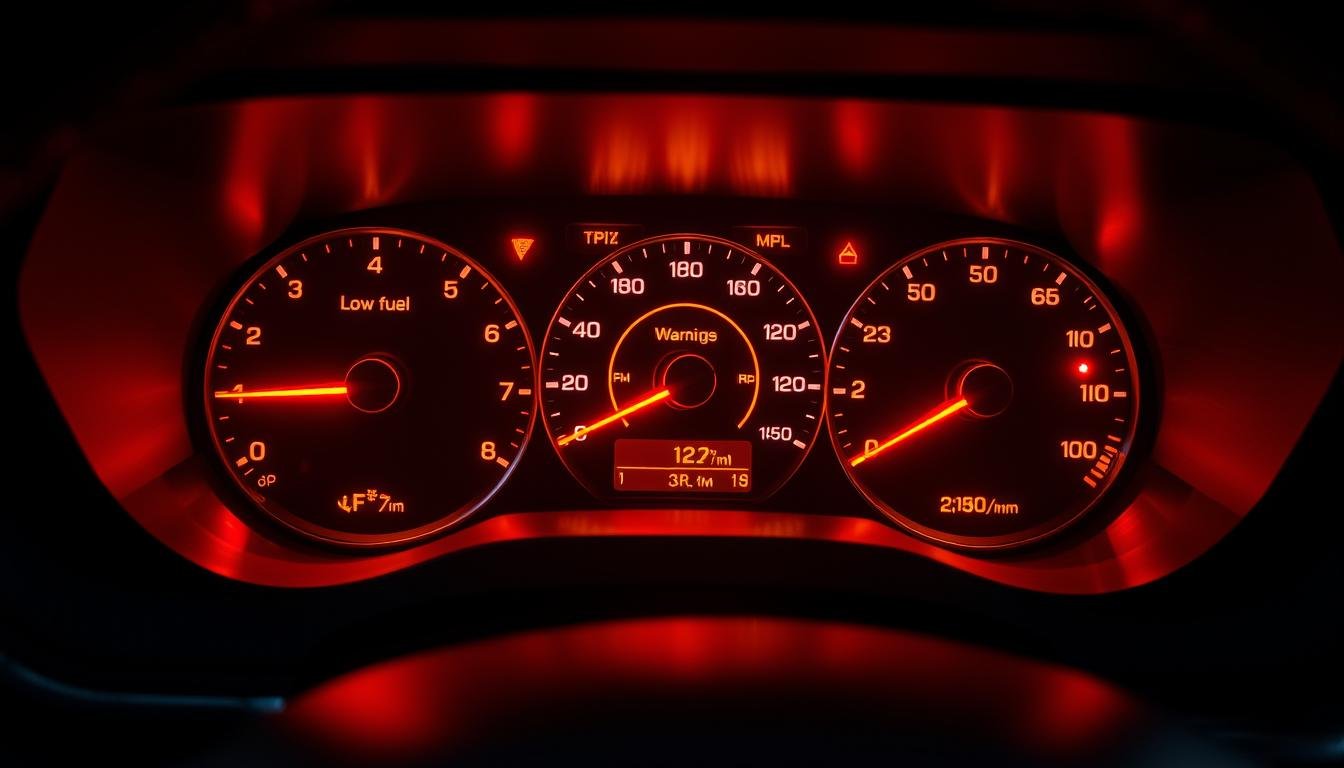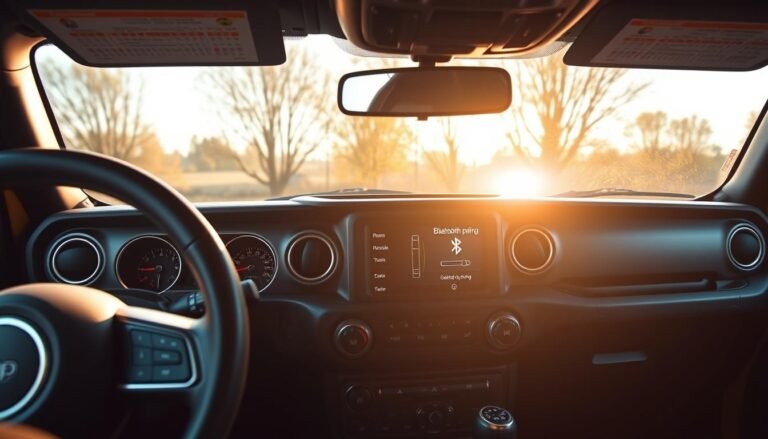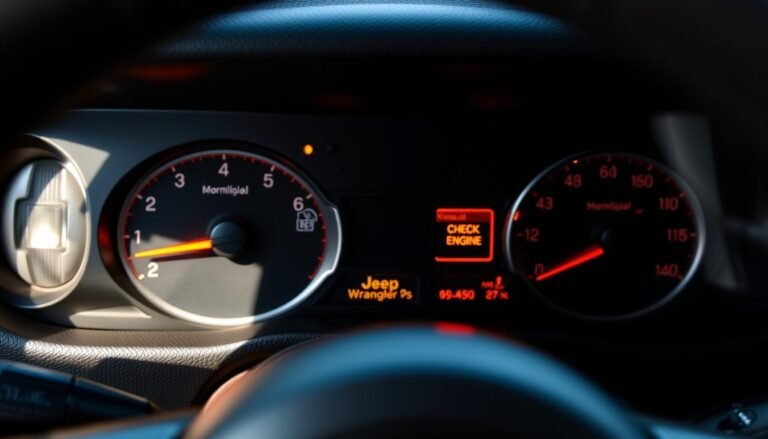Jeep Grand Cherokee Warning Lights Essential Guide
The Jeep Grand Cherokee warning lights are key to knowing your car’s health, showing issues that need looking into.
They’re crucial for taking good care of your car and staying safe while driving. In this guide, we’ll explain what different warning lights mean and what to do if they come on.
Compromise these symbols can help avoid big repair bills later and keep your Jeep running longer.
We’re going to look at important warning lights like the Battery Charge and Oil Pressure. You’ll learn what problems they might indicate and get tips on how to fix them.
We’ll also tell you when you might need to see a pro and how regular upkeep can prevent these warnings from popping up.
This guide will give you the know-how to take care of your Jeep Grand Cherokee and enjoy it without worries.
Introduction To Dashboard Warning Lights
Dashboard warning lights are your Jeep’s way of telling you what’s happening with it. Each light that turns on means something different.
It could be a small issue or a big problem that affects safety and how well it runs. Knowing what these lights mean helps you take care of your Jeep fast.
It’s important to keep an eye on these warning lights. By doing so, you help keep your Jeep reliable. You also avoid big repairs later on.
Knowing these lights lets you act quickly. This helps keep your Jeep Grand Cherokee running smoothly.
What is Jeep Grand Cherokee Warning Lights?
Knowing your Jeep Grand Cherokee warning lights is essential for every car owner. They light up on your dashboard, telling you about your car’s condition.
This way, you can act quickly and fix issues to keep your car running well.
What Are Warning Lights?
Warning lights are illuminated symbols on your dashboard that alert you to car issues. Each symbol shows a problem with a system, like the engine or brakes.
Learning these symbols helps you fix problems early. This keeps your Jeep Grand Cherokee safe and reliable.
Difference Between Warning and Indicator Lights
Warning lights and indicator lights on your dashboard are different. Warning lights show serious issues needing immediate action, like engine or oil problems.
They prompt you to act fast to avoid harm. On the other hand, indicator lights just update you on vehicle functions, like when your turn signals are on.
Knowing these differences helps you take good care of your car.
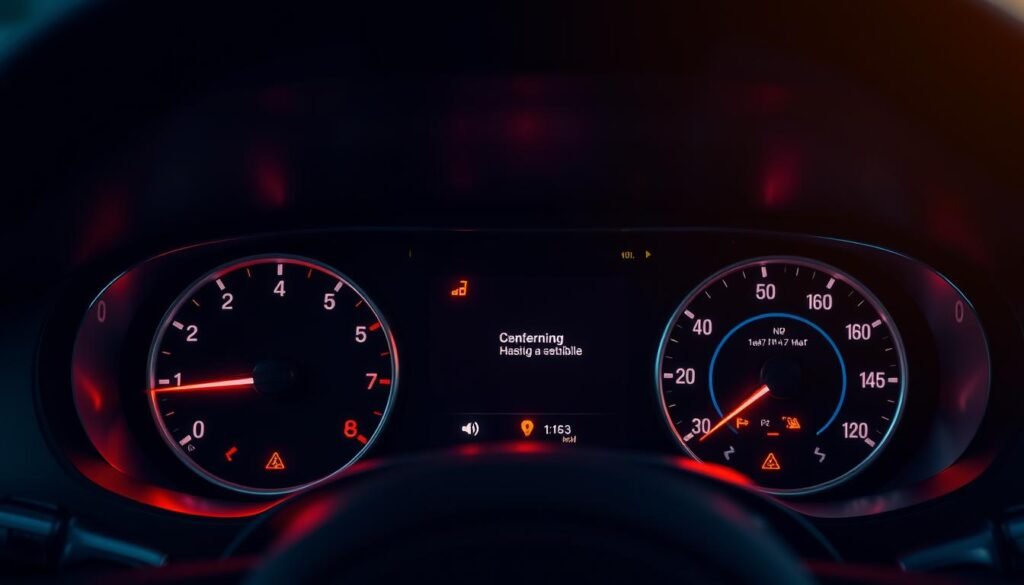
Important Jeep Grand Cherokee Warning Lights
Your Jeep Grand Cherokee’s dashboard lights are crucial for the car’s health. They help you know when to maintain your vehicle for safe drives.
Pay attention to these dashboard symbols to keep your car in top shape.
Battery Charge Warning Light
The red battery symbol means there might be an issue with the electrical system. If it lights up, it indicates that the battery might not charge right. You should address this quickly to avoid being stranded.
Oil Pressure Warning Light
This light looks like an oil can and warns of low oil pressure. This could be due to leaks or incorrect oil levels. It’s important to fix this fast to prevent engine damage.
Tire Pressure Monitoring System Warning Light
A yellow light warns you of low tire pressure, affecting safety and handling. You should check your tires straight away.
Maintaining the right tire pressure ensures safe driving and helps avoid accidents.
Engine Check/Malfunction Warning Light
This light means there’s a problem, possibly a loose gas cap or a serious engine issue. Solving this quickly helps avoid more problems down the line.
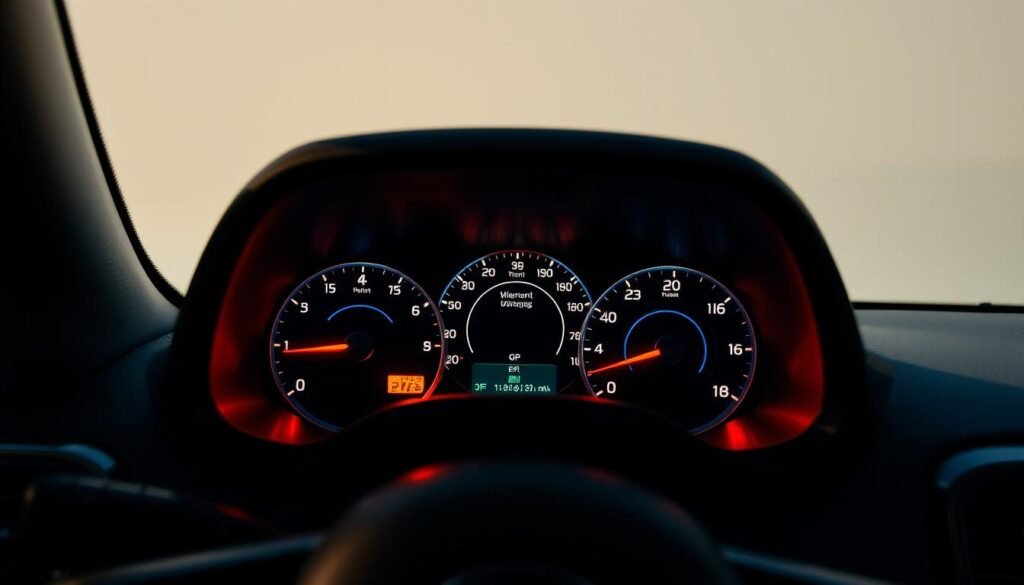
| Warning Light | Description | Action Required |
|---|---|---|
| Battery Charge Warning Light | Indicates charging system issues | Check battery and charging system |
| Oil Pressure Warning Light | Signals low oil pressure | Add oil or check for leaks |
| Tire Pressure Monitoring System Light | Alerts low tire pressure | Check and adjust tire pressures |
| Engine Check/Malfunction Light | Indicates engine control system issues | Perform diagnostic checks for error codes |
Jeep Grand Cherokee Warning Lights Troubleshooting Guide
When warning lights flash on your Jeep Grand Cherokee’s dashboard, it’s crucial to know what they mean.
Each light points to a possible issue needing quick attention. This can stop bigger problems later on.
Common Issues and Solutions
Many problems with Jeep Grand Cherokee warning lights have simple fixes. Below, you’ll find common alerts and how to address them:
- Oil Pressure Light: Check your oil if this light comes on. Add oil if it’s low and look for any leaks.
- Battery Charge Light: Check the battery’s connections and health. The issue might be a bad battery or poor connections.
- Tire Pressure Light: Make sure all tires have the right pressure. Inflate them to the suggested level.
- Engine Check Light: This light often means you need to look deeper. A diagnostic scan can help find the problem.
When To Seek Professional Help?
Some Jeep Grand Cherokee warning lights signal serious issues. Don’t ignore lasting lights, like the engine check or brake warnings.
Getting expert advice can pinpoint the problem. This also stops further harm to your Jeep. Keeping up with your Jeep’s care is key to its best performance.
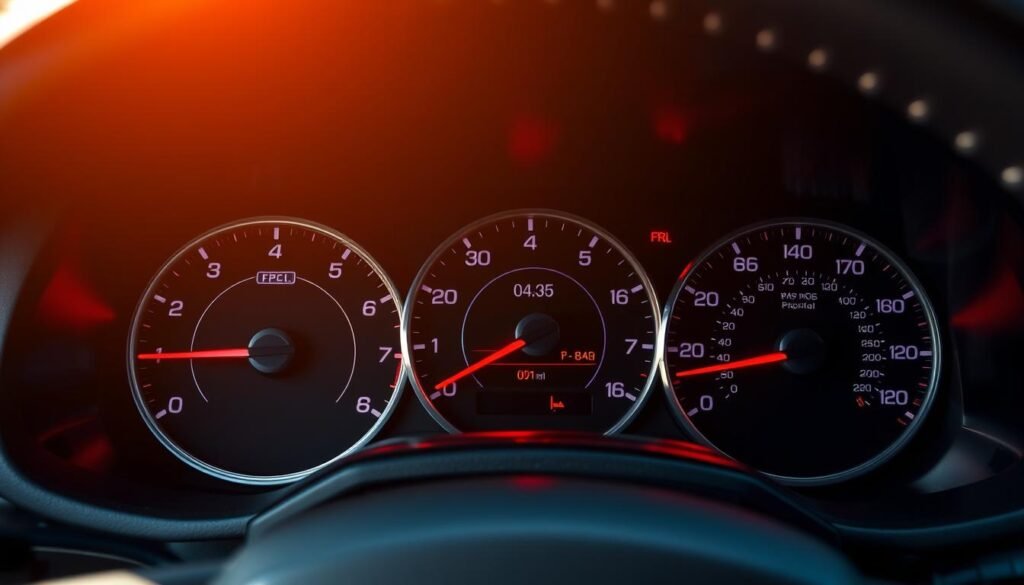
Additional Dashboard Symbols and Indicators
Knowing what the dashboard symbols and indicators mean in your Jeep Grand Cherokee is key for good driving.
These lights show how different systems in your car, like the headlights and driver help tools, are working.
Learning what these symbols mean helps you keep your car running well and take action when needed.
Indicator Lights Explained
Indicator lights tell you important things as the driver. They show the status of many parts in your Jeep Grand Cherokee.
For example, lights on the dashboard show when your headlights or turn signals are on.
Compromise these symbols makes your driving better by keeping you informed about your car’s condition.
Driver Assistance and Safety Indicators
The latest Jeep Grand Cherokees have new driver help and safety tools that make driving better.
You’ll see dashboard symbols for things like collision warnings, lane departure alerts, and cruise control.
It’s important to know what these symbols mean for using your car’s features safely.
| Indicator Symbol | Description | Action Required |
|---|---|---|
| ☀️ Headlight Indicator | Headlights are turned on. | No action required. |
| 🚧 Lane Departure Alert | Warning when drifting from lane. | Steer back to the lane. |
| ⚠️ Forward Collision Warning | Potential collision detected. | Prepare to brake. |
| ⛔ Adaptive Cruise Control | Adaptive cruise control engaged. | Adjust speed as needed. |
Taking Action on Illuminated Dashboard Lights
If you see dashboard lights on in your Jeep Grand Cherokee, act fast. Each light tells you what to do next for safety and to keep your vehicle running well. Quick action helps avoid more damage.
Immediate Actions To Consider
Here’s what to do if you see dashboard lights on:
- Engine Temperature Light: Turn off the engine to stop it from overheating. Let it cool before checking the coolant.
- Tire Pressure Monitoring System (TPMS): Stop and check your tire pressure. Inflate the tires if needed.
- Battery Charge Warning: Look at the battery and alternator. Get professional help if the issue continues.
- Oil Pressure Light: Pull over and check the oil. You may need to add more if it’s low.
Routine Maintenance To Prevent Warning Lights
Regular maintenance is key in avoiding warning lights. Here are some maintenance tips:
- Change the oil as the maker suggests.
- Make sure your tires are rotated, aligned, and balanced.
- Have your brakes checked regularly to ensure they work well.
- Change air and fuel filters to keep the engine running smoothly.
Keeping up with maintenance extends your vehicle’s life. It also lowers the chance of dashboard lights turning on unexpectedly.
These tasks improve your car’s performance, making your rides smoother.

| Warning Light | Immediate Action | Routine Maintenance Tips |
|---|---|---|
| Engine Temperature | Turn off the engine | Regular coolant checks |
| Tire Pressure | Check tire pressure | Routine tire rotations |
| Battery Charge | Inspect battery and alternator | Maintain battery connections |
| Oil Pressure | Check oil level | Regular oil changes |
Deciphering Diagnostic Codes
It’s very important to understand and get OBD-II codes for your Jeep Grand Cherokee. These codes give us vital info about our car’s systems.
They show potential issues. Thanks to special diagnostic tools, we can quickly find and fix problems.
Using OBD-II Codes For Troubleshooting
OBD-II codes point out exact problems in your vehicle. If you see warning lights on your jeep grand cherokee, these codes help figure out the cause.
Each code matches a specific fault, making it easier to solve the problem. Here is a table with some common OBD-II codes and what they mean:
| Code | Description |
|---|---|
| P0300 | Random/Multiple Cylinder Misfire Detected |
| P0420 | Catalytic Converter Efficiency Below Threshold |
| P0455 | Evaporative Emission Control System Leak Detected (Large) |
| P0171 | System Too Lean (Bank 1) |
Professional Diagnostic Services
Sometimes, car issues are complicated and need professional checks. Skilled technicians with advanced tools know a lot about jeep grand cherokee warning lights.
They do detailed checks to make sure your car runs well. Using their help saves time and gives you confidence that your Jeep is cared for by experts.
Staying Informed: Common FAQs About Dashboard Lights
Learning about dashboard lights FAQs is very helpful for Jeep Grand Cherokee owners. Many people have questions about warning lights and what they mean.
This information helps clear up those questions and explains how to fix problems.
- What do dashboard lights indicate? Dashboard lights are warnings about different parts of your vehicle. Each light tells you something specific about your Jeep Grand Cherokee’s condition.
- What should I do if multiple warning lights activate? When several warning lights turn on, it’s critical to check them out. Make sure you are safe, then look up the lights in the owner’s manual for more information.
- How can I interpret warning symbols? Learn the meanings of symbols in your owner’s manual. This helps you quickly deal with any issues.
- Is it safe to drive with a warning light on? This depends on the warning light. Some suggest small problems; others mean something more serious. Your safety is most important, so get help if you’re not sure.
- How often should I check dashboard lights? Checking your lights regularly helps spot problems early. Pay attention while driving and handle any lit dashboard lights quickly.
- What resources are available for dashboard lights FAQs? Use your Jeep Grand Cherokee owner’s manual to understand dashboard lights. Jeep forums and dealership services can also provide more help.
Jeep Grand Cherokee Warning Lights Best Practices
Looking after your Jeep Grand Cherokee means keeping an eye on warning lights and doing regular maintenance.
It’s important to inspect your vehicle often to catch problems early. Make sure to check all parts of your Jeep for the best performance and safety.
This way, you’ll see fewer warning lights and enjoy a smoother ride.
Regular Vehicle Inspections
Inspecting your Jeep Grand Cherokee often is key to its well-being. Here are some tips to make your inspections more thorough:
- Inspect fluid levels, including oil, coolant, and brake fluid.
- Examine tire condition and pressure regularly to prevent warning lights.
- Check brake functionality and ensure responsiveness.
- Assess various vehicle systems, including lights and signals.
Taking these steps early can spot and fix problems, helping your Jeep run better.
Learning Your Owner’s Manual
The owner’s manual for your Jeep Grand Cherokee is packed with important info on maintenance and dashboard symbols.
Taking the time to learn from this manual helps you:
- Acquaint yourself with jeep grand cherokee warning lights and their meanings.
- Follow recommended maintenance schedules for vehicle longevity.
- Utilize troubleshooting information to address issues effectively.
Knowing your manual well not only helps you understand warning lights. It also gives you the skills for great vehicle care.
Conclusion
Knowing what your Jeep Grand Cherokee’s warning lights mean is key to safe and smooth driving.
These lights are like your car talking to you, telling you when something isn’t right. Getting to know these signals helps you catch problems early, avoiding bigger troubles later.
Keeping an eye on your dashboard and fixing warnings quickly makes a big difference in your drive.
This approach not only keeps your Jeep running well but also makes it last longer. You’ll get to enjoy driving your car for many more trips.
Make it a habit to check your Jeep’s warning lights and be familiar with your owner’s manual. This knowledge prepares you to deal with car issues effectively.
You’ll drive safer and more confidently, knowing you can handle whatever comes your way.
FAQs
Q: What should I do if the engine check light comes on?
A: When the engine check light turns on, first check the gas cap. It might be loose. If tightening it doesn’t help, see a professional. They can find and fix the problem to avoid major troubles.
Q: How can I check my tire pressure?
A: Checking your tire pressure is easy. You’ll need a tire pressure gauge. Put it on the valve stem and note the reading. Compare this with your owner’s manual’s suggested pressure.
Q: What do I do if multiple warning lights are on?
A: With several warning lights on, focus on urgent ones like brake or oil lights. Getting help from a pro can find and fix the problems.
Q: How often should I inspect my Jeep Grand Cherokee?
A: Inspect your Jeep Grand Cherokee at least monthly. Look at fluid levels, tires, and brakes. This helps it run well and finds issues early.
Q: Where can I find the meaning of dashboard symbols?
A: Find dashboard symbols meanings in the Jeep Grand Cherokee owner’s manual. It explains what different lights mean.
Q: What does the battery charge warning light indicate?
A: The battery charge light shows there’s a possible problem with the electrical system. Check battery connections and its condition soon to dodge failure.
Q: Can I use OBD-II codes to diagnose issues myself?
A: Yes, OBD-II codes from a diagnostic scanner can highlight problems. Yet, understanding these codes well may need some car knowledge.
Q: How does routine maintenance impact dashboard warning lights?
A: Regular upkeep, like oil changes and tire services, ensures your car works great. It lessens dashboard lights and saves on repair costs.

